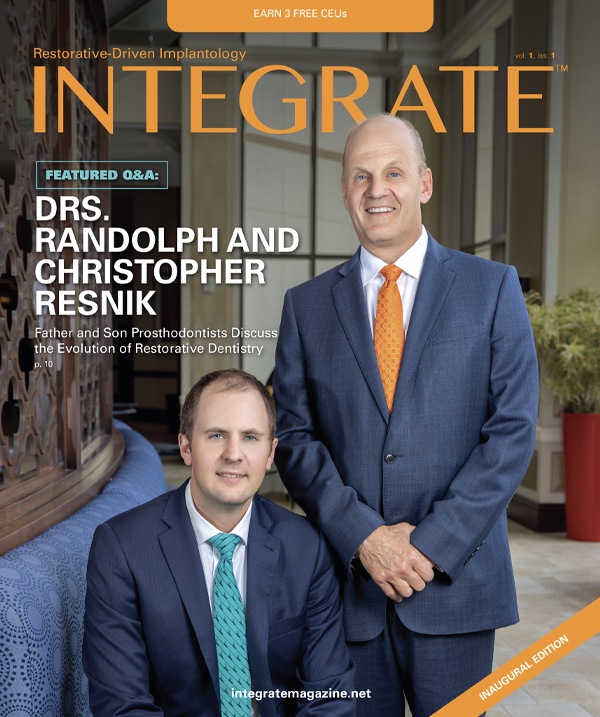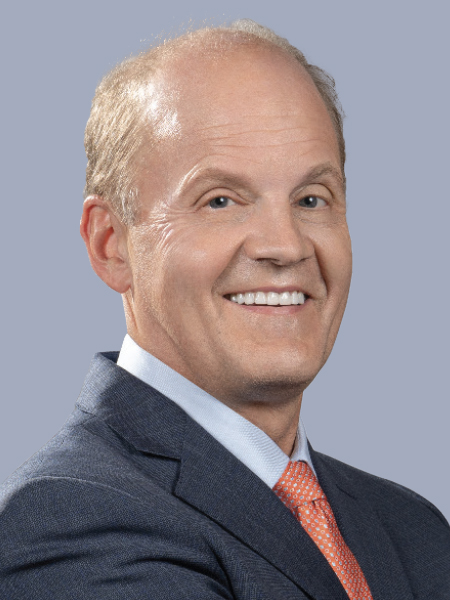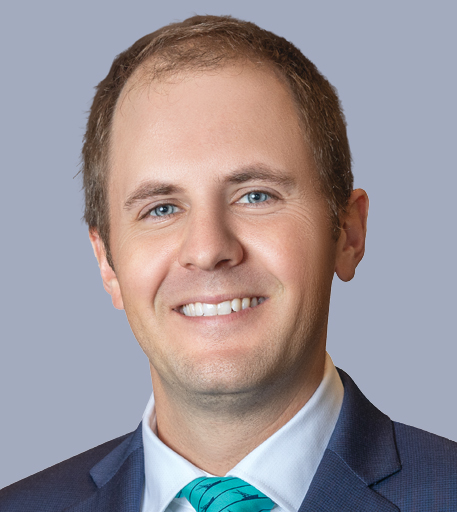Interview with Randolph Resnik, DMD, MDS and Christopher Resnik, DMD, MDS

With three generations of prosthodontists, the Resnik family presents a unique commitment to dentistry. I had the opportunity to speak with Dr. Randolph Resnik and his son, Dr. Christopher Resnik, about their family history, their engagement with implant dentistry, and their thoughts about the future of prosthodontics.
DR. NEIL PARK: Randy, let’s start with you. When you were growing up, your father was a prosthodontist. How did that influence your choice of career?
Dr. RANDOLPH RESNIK: My father, Dr. Rudolph Resnik, graduated in 1951 from the University of Pittsburgh and then completed advanced training in dental anesthesiology and prosthodontics in the Navy. He then went on to practice for almost 40 years in Pittsburgh as a fixed prosthodontist. When I was about six years old, I started going into the office and watching him in private practice. This early exposure to dentistry led to my desire to follow in his footsteps.
NP: When your father was practicing fixed prosthodontics, did it include any implant dentistry?
RR: Not at all. His practice was limited to traditional fixed prosthetics, which unfortunately at that time did not include dental implantology concepts. As a fixed prosthodontist, he specialized in full-mouth rehabilitation, often treating cases with insufficient abutments as well as large arch spans. When he was able to see how oral implantology impacted dentistry, he was truly amazed.
NP: Chris, let’s turn to you. You also grew up with a father who is a prosthodontist. How did that influence you? Did you look at other career choices, or did you know from day one?
Dr. CHRISTOPHER RESNIK: I knew from an early age that I wanted to be a dentist and follow in my father’s and my grandfather’s footsteps. With the integration of oral implantology, I knew this field would be exciting with unlimited future potential.
NP: Your father’s practice was significantly different than your grandfather’s because of the additional modality of implant dentistry. Is the way you practice prosthodontics different than your dad’s?
CR: Yes, I would say there are definitely differences between my current practice and my father’s. Just as there were technological advancements in his time compared to his father’s, incredible technological advances have changed the way I practice. While my father’s clinical practice initially relied on analog methods, digital methods and advanced materials now allow us to provide patient care in a significantly transformed manner. It’s truly remarkable how far we’ve come!
NP: We have a saying at Glidewell that you can’t digitize a process until you’ve got the analog process figured out. For example, designing a crown. If you don’t know what a crown looks like, and you can’t carve a crown in wax, you’re probably not going to be able to design it digitally.
CR: Exactly. We are fortunate we have had many years of research and development in the field of oral implantology by many true pioneers. They have paved the way for us to successfully treat patients more efficiently and predictably via surgical guides, 3D printing, scanning and digital smile design. However, understanding the foundation of implant dentistry and analog methods is invaluable to this process.
NP: Randy, you have practiced very successfully for many years without these digital tools. What do you think about them?
RR: Dentistry is changing so fast, especially in the field of oral implantology. I believe that digital technology is the most significant advancement in dentistry I have ever seen. We are now able to treat patients more accurately, which has allowed oral implantology to be a more prosthetic- and esthetic-driven modality.
NP: And, of course, we do all these things for the benefit of the patient. Specifically, how does this new technology benefit the patient?
RR: In the early days of oral implantology, it was common to place an implant where the bone was, and then a prosthesis would be fabricated to adapt to the implant position. Now, with digital technology, we can determine the final prosthetic outcome prior to initiating the surgical phase. This has resulted in a more predictable and esthetic treatment.
NP: Do these types of tools like digital surgical guides make for a more efficient delivery of care?
RR: Yes, even though I am more old-school in freehand implant placement, I appreciate the ease and precision of surgical guides. Oral implantology has changed drastically: Cases that were difficult or impossible to complete in the past are now being completed with precision through an easier surgical and prosthetic workflow.
NP: I’d like to ask you about some projects that I know you work on together. Randy, you’ve been active in writing the Misch series of implantology textbooks since 1991. Originally, you worked with Dr. Carl Misch on those textbooks, and I know since his passing, you’re still working on updating them like you were before.
RR: Yes, our field changes so dramatically that textbooks need to be updated regularly. In dedication to Dr. Misch’s lifelong commitment to oral implantology, I wrote a complications textbook in 2017. Since then, Christopher and I have updated both the surgical and prosthetic textbooks. When I look back on my relationship with Dr. Misch, I’m amazed at the foresight he had in the field. He was truly ahead of his time, and his core principles and classifications are still used as the basis for most common procedures to this day. It is truly an honor to carry on his legacy and to have Christopher be such an integral part of these new writings.
Oral implantology has changed drastically: Cases that were difficult or impossible to complete in the past are now being completed with precision.
NP: I admire your tenacity because you are always writing a textbook. The minute you finish a new edition of one, you immediately start on the new edition for another textbook. Particularly in the field of prosthetics, there’s been so much new technology and so much to update. Christopher, can you tell us some of the chapters that you’re writing and what topics you’re concentrating on in the prosthetics book?
CR: Yes, it has been a true honor and very exciting to help contribute to these textbooks with my father. My major goal in both the surgical and prosthetic textbooks has been to incorporate the digital workflow for both the surgical and prosthetic phases of implant dentistry. Additional topics discussed in these textbooks include updated methods for testing osseointegration, stackable surgical guide workflows, immediate load protocols, and the utilization of photogrammetry and CAD/CAM technology in implant dentistry.
NP: Chris, you haven’t been out of dental school for very long, and you know the way that students use textbooks today is different than how they used textbooks 30 years ago. When you have such a comprehensive textbook like this, what’s the best way for a dental student or a practicing doctor to use this book and get the most out of it?
CR: The textbooks are uniquely written to encompass the entire implantology process. Whether you are a recent graduate or a seasoned implant clinician, I believe reading the books cover to cover is most important. Unfortunately, there often is not enough time for students to learn advanced topics like oral implantology. Similarly, the field has changed so drastically that even well-experienced doctors still will benefit from reading the textbooks in entirety. These textbooks, which are constantly updated, mirror the educational curriculum at the Resnik Implant Institute. This can be seen by the number of past graduates, as far back as the 1980s, who return to the institute to learn the latest advancements and procedures in our field. With each course, we are constantly updating the curriculum to follow the latest techniques, literature and technology.
NP: I remember the first time I went through the implant program, Randy started by talking a lot about socket grafting. He explained that the course would pay for itself in a couple of weeks if we started grafting sockets. It’s a tremendous program and that is why it has been so successful. I know you are now an integral part of the Resnik Institute, right?
CR: Yes, after completing my residency program, I remained highly involved with the Resnik Institute. Interestingly, it continues to become even more of a family affair: My mother, who is a registered nurse, and my wife, who is a general dentist, actively contribute to the Resnik Institute’s daily operations. It’s truly incredible to see our shared dedication and commitment to advancing the Institute’s mission of ensuring the success of every doctor.
NP: Randy, how has the curriculum at the Resnik Institute changed since Christopher joined your faculty?
RR: Each time we offer a course, we make it a priority to update the curriculum and incorporate the latest advancements in our field. Staying current with the ever-evolving knowledge and technologies is crucial for providing our students with the best possible education. Our goal is to teach doctors the philosophy and protocols first, then implement these concepts in hands-on laboratory sessions. With the help of Glidewell, I believe our hands-on labs are unprecedented in the field. The curriculum has allowed both seasoned doctors and those with little-to-no experience in implantology to implement this education into their own practices. We’ve developed the curriculum into five sessions, and each session builds upon the previous one: socket grafting, atraumatic extraction, single implants, multiple implants and bone grafting. This continuum format has worked for over 35 years, and I think it’s the best way to learn how to implement implant dentistry into your practice.
NP: There are so many courses in the world of implant education right now, but your enrollment increases and consistently sells out. Why do you think the Resnik Institute continues to grow, despite there being so many courses out there?
RR: Our best referrals are doctors who have already taken our courses. This tells us that our curriculum is effective and has a positive impact on the lives of our doctors. We integrate every aspect of the implant process, including medical evaluation, radiographic analysis, comprehensive treatment planning and postoperative maintenance. All these aspects play a significant role in every single clinical situation we encounter. In fact, we have so much valuable information to share on a given weekend that we’ve launched an online platform to share additional information. Through this platform, doctors can watch multiple lectures and undergo self-assessments through quizzes prior to attending the live course. I believe that the reason our enrollment continues to increase is because we have learned what works and what doesn’t. At the Resnik Institute, we prioritize the success of doctors. Our focus is on providing valuable insights and knowledge that will keep doctors out of trouble and enhance their overall professional journey.
NP: The institute is more than 30 years old. You know what works; you know what doesn’t work. You know how doctors are successful, and you know the areas they can get in trouble. I think that’s what gives your institute such a great reputation in the market.
RR: Yes. That is what keeps us motivated at the Resnik Institute to continually take the curriculum to a higher level. It is very satisfying when we see doctors continually come back to repeat courses and program alumni refer their colleagues to us.
NP: At Glidewell, we’ve been associated with you and the Resnik Institute since 2015. It’s certainly been a great experience for us to work with the institute and the high-quality education that you deliver. How has our partnership affected the institute?
RR: Well, I don’t think we could have done it without you! Glidewell supporting us has been unbelievable. If Christopher or I have a vision of a new procedure, lab or material, Glidewell will make it happen. I believe that we’re keeping up to date because Glidewell is the largest dental lab in the world, and their remarkable accomplishments in the field highlight their progressiveness. Their support and abundant resources are why we’ve been so successful and continue to be successful.
Our focus is on providing valuable insights and knowledge that will keep doctors out of trouble and enhance their overall professional journey.
NP: It’s been a great experience for us as well. Christopher, at what stage in a young doctor’s career should he or she sign up for the Resnik Institute? Is this something they should attend right out of dental school, or do you think they’re better off practicing for a couple of years before they jump in?
CR: Dental clinicians must be well versed in all aspects of dentistry. Oral implantology is such an important component of dentistry that a recent graduate must learn these procedures early on to be successful in private practice. Unfortunately, dental students have limited exposure to oral implantology in dental school. This is why we are seeing more and more recent graduates, even dental students, taking our courses. In fact, two universities actually send their specialty residents to the Resnik Institute for their implant education.
NP: Being able to place and restore implants adds so much to the production of a practice. It’s a core practice investment. You wouldn’t try to practice without an X-ray machine. Why would you try to practice without some of the key skills that would make you successful?
CR: Every day in private practice, I use implant-related concepts. I couldn’t imagine not having the education to provide this service to my patients. The continuity of taking care from start to finish is very gratifying.
NP: So, Randy, does the Resnik Institute have other programs besides the main continuum?
RR: Yes. We have a program called the “Prostho Boot Camp.” This is a very comprehensive course that spans three 10-hour days. We ensure that our attendees receive the most up-to-date information and protocols on how to restore implants successfully, safely and with increased longevity. This includes a didactic portion as well as very extensive hands-on laboratory sessions with the most advanced technological procedures. We also have a dental implant complications course. This is the most comprehensive course in the program, covering all surgical, prosthetic, medical and legal complications involved within oral implantology. This year, we are adding two new courses: one on digital workflows for full-arch protocols and another on all-on-x laboratory procedures for lab technicians.
NP: I’ve been in this field a long time, and the training kits that you and the Glidewell team have put together are beyond anything else in the teaching of implant prosthodontics. The number of different scenarios that you’ve set up and the number of procedures that doctors get to practice is incredible.
RR: I have Glidewell to thank because, when we teach a procedure, the attendee has the opportunity to complete a hands-on scenario. Glidewell has provided that unprecedented ability to simulate these procedures in a lab setting.
NP: Now, I understand that in the last few years, you’ve also been running a live surgery program. Can you tell me about that?
RR: Back in the 1980s and 90s, we had a live surgery program, but it became difficult for out-of-state doctors to treat patients due to state licensure. Now, we have our program in Ohio that allows doctors to perform procedures with a temporary continuing education (CE) license. Our course offers attendees the flexibility to choose and perform any procedure they want, whether it’s socket grafting, guided bone regeneration, sinus lifts, or single or multiple implants. This course has changed clinicians’ lives. It provides them the opportunity to learn these procedures in a teaching environment, and then gives them the confidence to perform them in their own practice.
I have Glidewell to thank because, when we teach a procedure, the attendee has the opportunity to complete a hands-on scenario.
NP: And the doctors that take the live surgery program are doctors who have finished the surgical restorative continuum already?
RR: Yes. To participate in the live surgical course, you have to be a graduate or current attendee of our surgical continuum or prosthetic program.
NP: Excellent. Well, it is certainly a remarkable program. What is your most memorable experience in your long career as an educator, clinician and researcher?
RR: I would have to say last year’s Complication course in Las Vegas with Gordon Christensen. That three-day course was unbelievable. With over 250 attendees, I was able to lecture with my son Christopher and my daughter Allison. Christopher lectured on digital technology and all-on-x complications. Allison, in her last year of an ophthalmology residency in Boston, lectured on sinus and ocular complications from zygomatic implants. Having the ability to lecture side by side with my son and daughter was truly the most memorable experience in my career.
NP: And Christopher, what is your most memorable experience?
CR: I would have to say every Resnik Institute course is a memorable experience. Having the opportunity to work alongside my father in a constantly evolving field is truly amazing. It is very rewarding to know that many of the principles taught today have been set forth by my grandfather’s generation in the field of fixed prosthodontics, and how my father’s and Dr. Misch’s efforts have made such an impact on so many doctors’ lives in the field of oral implantology.
NP: Well, thank you. I’m certainly looking forward to meeting the fourth generation of Resnik prosthodontists!








